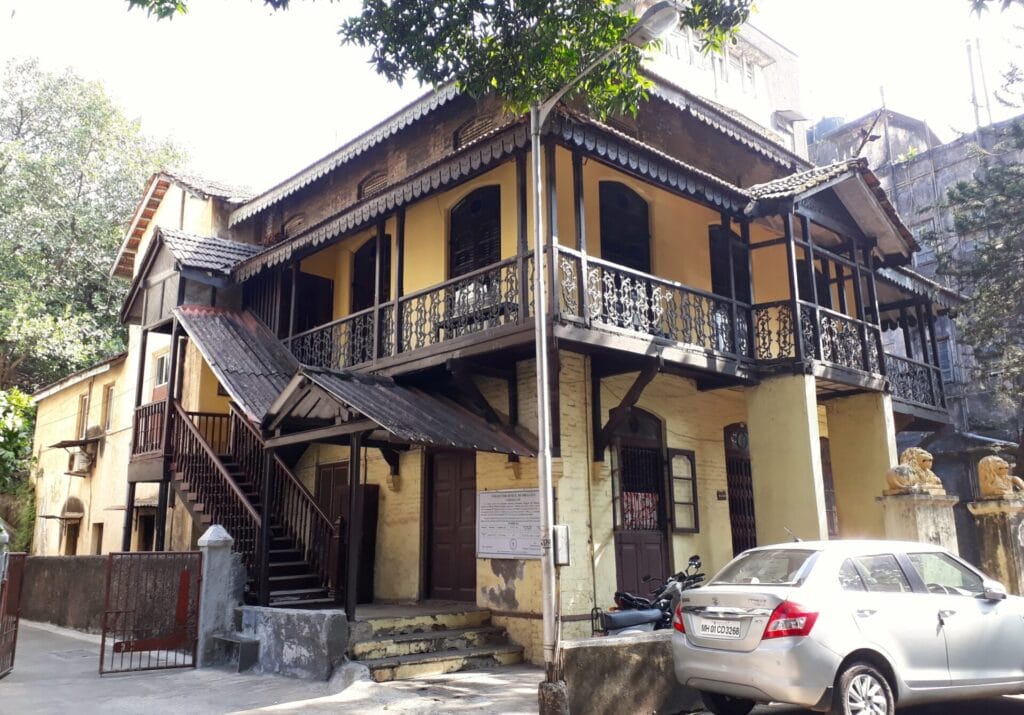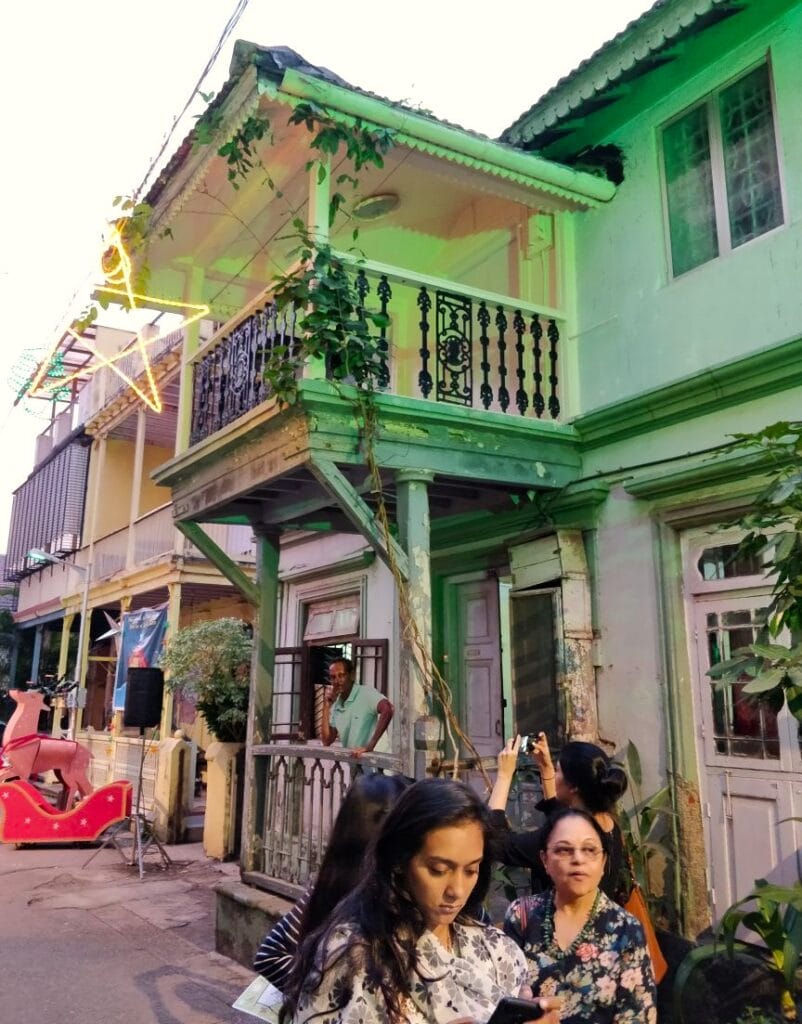Renie Baptista, lives in a 100-old-legacy house in Matharpacady. The house, inherited by her father-in-law from his mother, invokes a mixture of legacy, emotional attachment to the neighbourhood, where people share similar cultural and social ethos. She also enjoys a sense of space in her 2000 sq ft bungalow, which, even now, is a sturdy house.
Shifting into a flat that could come with water and other infrastructural issues bothers her along with the worry of losing her link with her community spaces forever. Many others in Matharpacady share her anxiety.
The quaint old charming bungalows and bylanes of Mazgaon village may soon be history as they are proposed to be replaced by skyscrapers with flats.
Matharpacady, or the village of the elderly (mathar = elderly, pakhadi= village) as the sleepy old Mazgaon village is known, is one of Mumbai’s few vintage localities that continues to exude history, heritage and charm all in the same breath.
Historical significance of Matharpacady
Many of its distinct Indo-Portuguese bungalows with open balconies, sloping roofs, colourful facade, ornate grills are over a century old and many houses showcase their age with pride on a plaque.
Political figures like Joseph kaka Baptista, compatriot of Lokmanya Tilak who co-founded the All India Trade Union Congress (AITUC) and free Bombay’s first mayor, Dr Ubaldo Mascarenhas, were from Matharpacadi.
Every nook and corner is seeped into history, right from the lone mango tree, its fruits relished by the Mughals to the Lion’s Den, the house built in 1892 that has two stone lions guarding its entrance. At the heart of the village is the Holy Cross Oratory, a chapel built in 1875, dedicated to Saint Roque, the patron saint for pestilence for protection from the Bubonic plague that left this village unscathed.

Mazgaon was heavily influenced by the seafaring community, thanks to its proximity to the Mazgaon docks. The area had kudds or dormitory residential facilities that were patronised by the Goan seafarers. They used to halt in Mumbai before proceeding to Goa, which didn’t have an international port back then, recalls Rafique Baghdadi, veteran journalist and historian. Rafique is an old resident of Mazgaon, who pays tribute to this heritage by hosting walks and showcasing the distinct historical value of his place.
Proposed cluster development
Modern high rises have been coming up on the periphery of the village over the past few years.
In October, 2023, over 395 residents – 235 of them residing in the village, the other 160 in a transit camp – got to know about a proposed cluster redevelopment plan, when they received letters from the developers offering redevelopment of their houses. Residents are being promised bigger houses in buildings – those residing in 300 sq ft houses will get 550 sq ft houses, while those in space beyond that will get additional 60% space. Shopkeepers have been offered to turn their shops into residential spaces of 550 sq ft.
Developer Rajendra Chaturvedi, chairman of Shreepati Build Infra Heritage Private Limited, that is redeveloping Matharpacady as part of a cluster development told Hindustan Times that he had already received consent for development from 705 residents including landlords and tenants. “I don’t need any more, but I’m trying to get everyone’s consent and I’m confident I will. To sweeten the pot even more, I’m offering the landlords Rs 50,000 per sq m,” the newspaper quoted him as saying.
Many bungalows are occupied by tenants under the pagdi system, with owners having migrated abroad. Most of the area was on lease by the government that ended and was not renewed. Instead, residents found notices for redevelopment.
The communities too have undergone distinct change. Though the exact numbers are not known, the old East Indian Catholics and the Parsi communities have moved out and the Bohri Muslims and Jain community have shifted.
Read more: “Koliwadas are Mumbai’s living heritage and must be conserved”
Resistance by residents
The redevelopment plan was like a bolt from the blue for residents, who have been resisting the multi-storied matchbox-style real estate change for more than a decade now. Residents took out a candle march on November 3, 2023 to highlight their resistance against the move.

Residents are trying to create awareness about the heritage value of their precincts through various initiatives. They are also trying to document the unique heritage features of their locality and trying to get the tag of UNESCO heritage status to protect their precincts. The residents are gearing up to put up a legal fight against being coerced into cluster redevelopment.
Heritage regulations for redevelopment
Losing Matharpacady to redevelopment would be a real shame as its loss would mean a loss to an entire layer of history of Mumbai, rues Pankaj Joshi, conservation architect and urban planner, who was a member of the Mumbai heritage panel.
Unlike Grade-I heritage buildings that are completely barred from any major kind of structural changes, minor works are permitted in Grade-II heritage structures.
However, provisions of Development Control and Promotion Regulations (DCPR) 52 with respect to DCPR 33 (9 ) Cluster Redevelopment have been relaxed and do not require a nod from the Mumbai Heritage Conservation Committee for Grade-III buildings and precincts, reveals Pankaj, who is also trustee of the Urban Centre Trust. Matharpacady falls in this category.
“The culturally significant century-plus-old vintage village of Matharpacady faces the threat of being irrevocably wiped out from the city. The core value of heritage of our city will be lost forever,” says Pankaj.
Read more: A fight to save a heritage tree in Mumbai
Redeveloping Matharpacady: Loss for Mumbai
Mumbai has very few pockets that retain its distinct historical significance. The fight put up by the few residents against the winds of change means more than a fight for land or house. It is a fight by old charming Mumbai against the gentrified matchbox Mumbai, the fight to retain living in their olden ways rather than give in to living in the generic way of life.
“Major cities across the world, be it London, Paris or Stockholm, continue to retain and protect their old spaces in areas that are generally termed ‘old town’. Why can’t we do it here for places like Matharpacady that hold such historical significance? Such places need to be preserved for their heritage and their cultural significance. Tourist potential needs to be developed to sustain upkeep,” says Anita Yewale, co-convenor of Indian National Trust for Art and Cultural Heritage (INTACH), which works on heritage conservation.

She believes that the fight for Matharpacady is a struggle to retain its living heritage through architecture, festivities and culture.
“They (the government) do not realise that if such precincts are developed well, they could shine on for another century, rather than just give in to the immediate temporary gains. Any kind of development must take into account the local sentiments and centuries old life and culture of the space. The cultural fabric of the city must be guarded, protected and must be made sustainable,” she says.
Can Mumbaikars support heritage communities?
At stake in Matharpacady is much more than just another redevelopment project. “Just because the next generation may have dwindled in numbers and may have migrated, is no excuse for Mumbai as a city to lose its distinct cultural layered identity,” emphasises Pankaj.
Considering the cultural significance of the area and its heritage value to Mumbai, Pankaj suggests that along with the Mumbai Heritage Conservation Committee, the entire Mumbai city should be consulted democratically in such a major decision making process.
This could be done by using relevant provisions of the Maharashtra Region and Town Planning Act, which necessitates calling for public suggestions and objections, public hearings, public consultations, and getting Mumbaikars’ opinion through crowdsourcing.
“The government should provide assistance to maintain these precincts, especially the houses, as they require costly care, which is not necessarily easy for people inhabiting these spaces today. That is where the government could really step in,” says Anita.
“Most of the bungalows were traditionally owned by the East Indian Community. The community is fighting similar battles to retain its distinct way of living in the 189 gaothans and 40 koliwadas across the city, says advocate Godfrey Pimenta of the Watchdog Foundation, who is providing legal assistance and is an East Indian himself.
“There is no incentive to maintain old property. Though there is a gaothan development fund, it is rarely used for infrastructural development in these gaothans. Unless the city comes forward, the heritage of these villages in Mumbai will be lost forever,” says Godfrey.